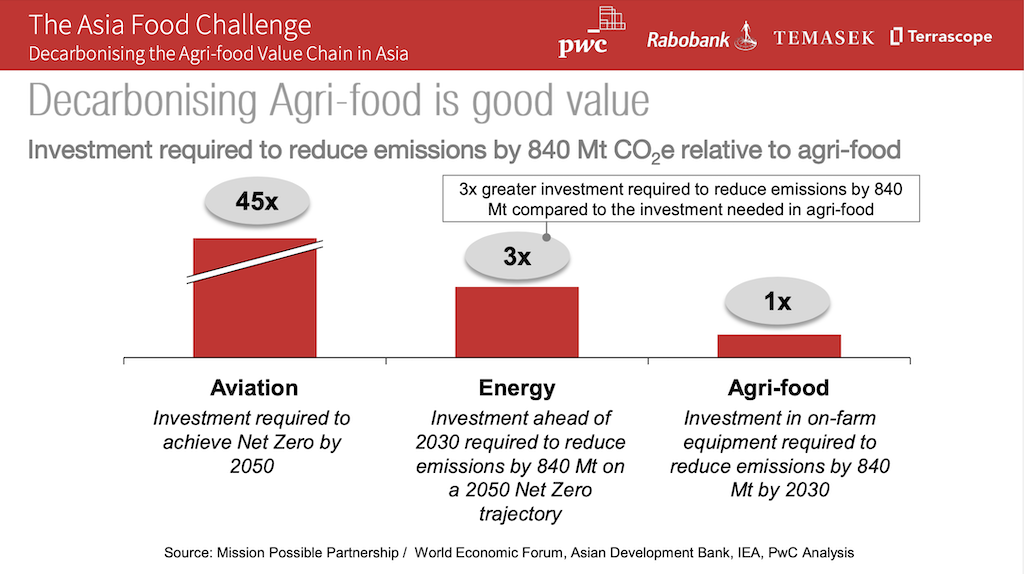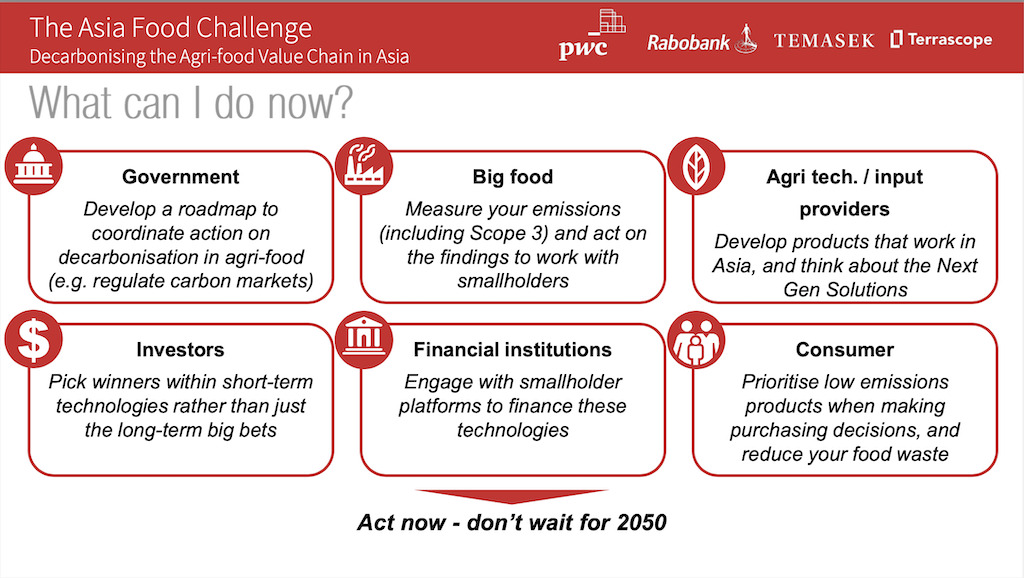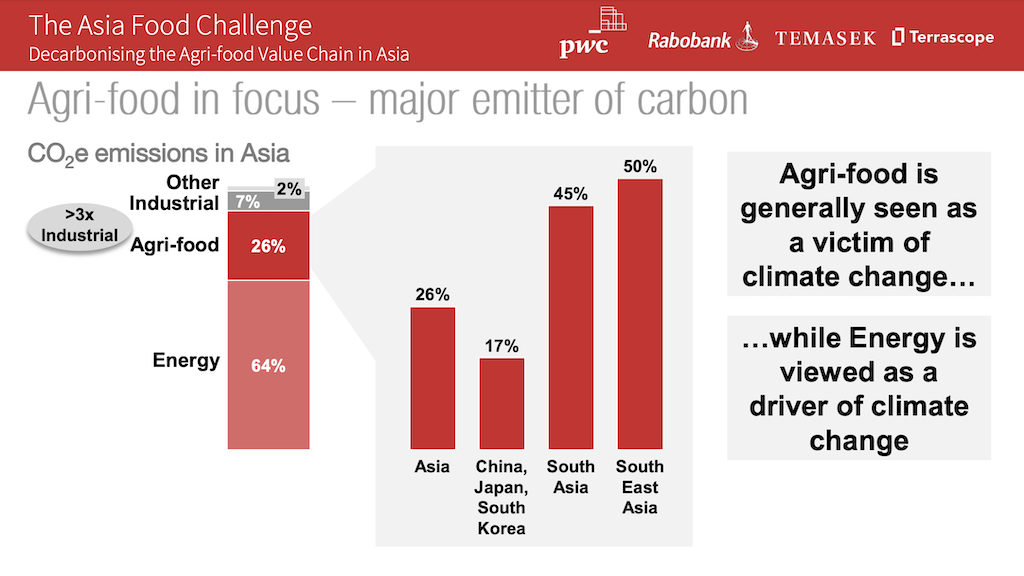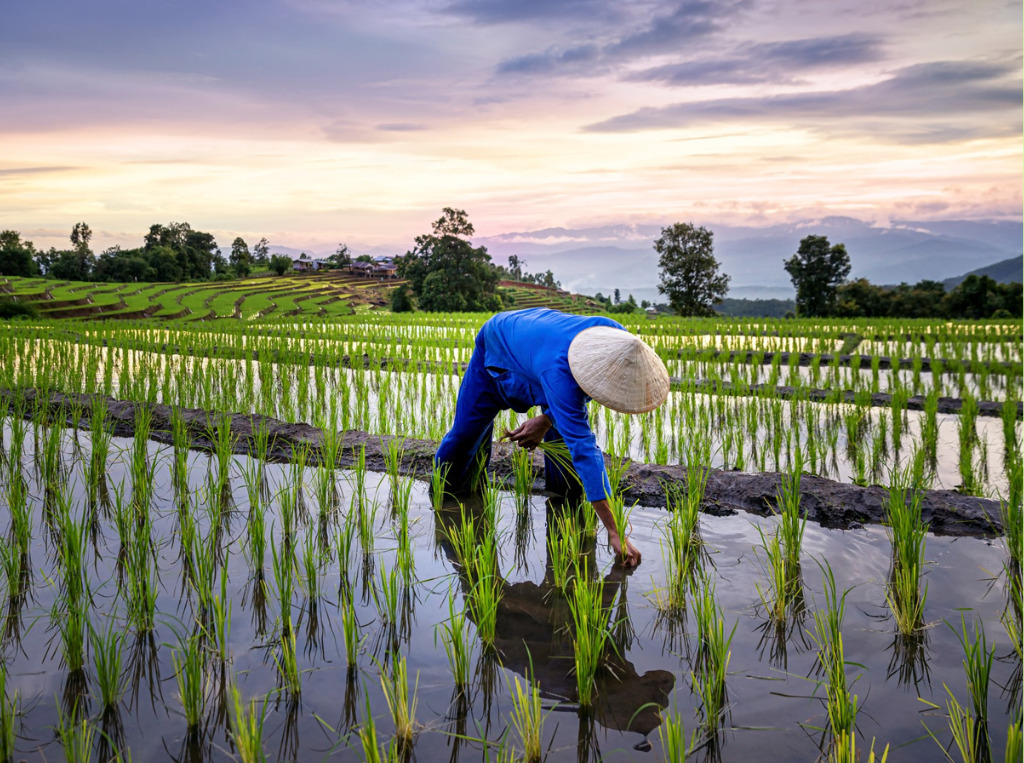Asia Decarbonisation: Invest $125B to Reduce Region’s Agri-Food Emissions by 12% by 2030, Says Temasek-Backed Report
6 Mins Read
A new report backed by major actors in Asia’s agrifood system including Singapore global investment company Temasek is calling for urgent climate action from industry stakeholders across the region to invest in tech and back existing solutions to help smallholder farms – doing so could reduce emissions by 12% by 2030.
The report, the third edition of the Asia Food Challenge Report titled Decarbonising the Agri-Food Value Chain in Asia and jointly published by strategic consultancy PwC, Dutch agrifood bank Rabobank, Singapore investment fund Temasek and carbon data firm Terrascope, got top billing during Singapore’s International Agri-Food Week (SIAW), which took place in the city-state last week. A media briefing was held at Rethink Event’s Asia-Pacific Agri-Food Innovation Summit and the report’s findings were cited by Singapore Deputy Prime Minister Heng Swee Keat in a speech during a gala commemorating the week’s events.
Agri-food systems: the lowest-hanging climate fruit
Agrifood systems account for a third of all global greenhouse gas emissions, second only to the energy sector. In South and Southeast Asia, this figure can rise to 45% and 50%, respectively. Additionally, the continent is responsible for about 42% of all agri-food emissions globally, despite only accounting for 35% of arable land.
There are multiple reasons for these high emission numbers, including a high number of smallholder farmers who are less efficient than large, mechanised farms, the importance of rice in Asia, and investment into Western-focused tech that may not apply to Asian farms. Approximately 50% of Asia’s emissions come from five areas: rice cultivation, fertiliser use, rearing of ruminant livestock and swine, food loss and waste, and deforestation. Crucially, two-thirds of emissions are released before the produce leaves the farm.
The report highlights the immense opportunity for decarbonisation in the continent, stressing the importance of improving food security and sustainability. It’s imperative that Asia, the world’s largest continent, makes a positive change to mitigate its climate impact – and the report outlines steps stakeholders at every level of the chain could take to do so. This ranges from embracing cleaner, more efficient technologies and reducing transportation carbon footprints, to fostering eco-friendly farming methods.
Globally, up to 95% of large agri-food corporate emissions are classed as Scope 3, notoriously the hardest emissions bucket to account for. Scope 3 emissions include indirect emissions from a company’s supply chains, all the way from extraction to disposal. The lack of reporting and data around Scope 3 emissions is often held up as a major barrier to decarbonisation progress and the report called for agri-food leaders to invest in better and more accurate emissions mapping and measuring.
Cutting emissions from food is cheaper than energy or aviation

For the first time, food systems were publicly called out as the most important lever in the fight against climate change, with the report underlining that investment required to reduce emissions by 840 million tonnes of CO2e (which would mean being on track to achieve net zero goals by 2050) in the aviation industry is 45 times what the same savings would be if the region invested in on-farm equipment. The same reduction in the energy sector would require three times the investment relative to agri-food.
The report outlines 20 technologies and practices available today to address the challenges faced by the agri-food sector immediately, with the authors claiming that this could help reduce emissions by 12% by 2030, which is equal to the emissions from the entire global aviation industry in 2022.
“Decarbonising Asia’s agrifood sector is critical to reduce the effects climate change has on our food resilience,” said Anuj Maheswari, Agrifood head at Temasek. “To do so, we need to prioritise the deployment of existing, readily available, and actionable solutions that can be scaled across the agri-food value chain and channel capital to catalyse the technology to accelerate decarbonisation in Asia and globally. This will enable the transition towards a greener and more sustainable agri-food system so every generation prospers.”
Change can only happen if all stakeholders –governments, large corporations, investors, academic institutions, farmers and consumers – take action, and the required cuts would need $125B of investment in farm-level equipment and machinery on rice and cattle farms, as well as financing of infrastructure and other farm types, according to the report. The earmarked investment is significantly less than what’s needed to have an equivalent impact in reducing emissions from the energy or aviation sectors.
This sum also has the potential to improve gross margins at the farm level by 16 percentage points. Plus, the opportunity for investors is apparent in the supporting tech, like micro-irrigation for changing rice cultivation practices, on-farm machinery suited to Asian smallholder farms, and digital engagement platforms to provide advice and funding to farmers.
The technology is there – the financial and social incentives are not

The report’s authors say actionable tech and practices should be prioritised over those at a lower level of technological readiness (which may have an impact in the future). Taking action before 2030 is crucial, as any emissions cuts will have an “outsized impact” in meeting climate targets. They argue that agrifood has received less focus on emissions than areas like the energy sector, and this needs to change if we’re to meet our decarbonisation targets.
It is largely the financial and social aspects that have a limiting impact on decreasing agrifood emissions – not the technology – something that isn’t true for the energy industry, which requires engineering and technical advancements to do so.
“There is a huge opportunity to improve Asia’s agricultural output per hectare by investing in technology, sharing best practices and assisting smallholders in adopting technology and best practices,” said Dirk Jan Kennes, Rabobank’s Asia head of RaboResearch Food & Agribusiness. “This not only increases food production per hectare or per animal, but it also contributes to decarbonisation in food production, which is vital for Asia’s road to net zero.”
He adds: “Helping farmers finance the adoption of technologies to decarbonise food production is critical for successfully reducing the carbon footprint of our food system.” Many of the actions need to be taken at farm level. The prevalence of small farms in Asia means stakeholders need to consider the best way to help them make this transition and cut emissions.
Large companies need to step up

However, large corporations are increasingly under scrutiny to act on their scope 3 emissions too, which include indirect emissions across their supply chain. Fewer emissions mean lower costs (for example, using less fertilisation) and/or more revenue (by valorising waste sidestreams, for instance), which adds another incentive for them to act.
“One of the exciting things about the 20 technologies and practices the report identifies is the added ability to improve the profitability of businesses across the supply chain, with many of them also representing significant investment opportunities,” said Richard Skinner, APAC deals, strategy and operations leader at PwC Singapore.
“There is further opportunity in the emergence of digital platforms, which are enabling farmers to access new markets and better inputs, and allowing big food organisations to work with the farmers growing the food to tackle their emissions.”
Terrascope CEO Maya Hari added: “The complex and fragmented nature of food and agriculture value chains makes emissions measurement, decarbonisation and [the] green innovation of this sector particularly challenging. Integrating the quantum and urgency of change with technologies such as machine learning and AI brings precision and speed to creating reliable emissions baselines and reduction forecasts. This enables companies to plan impactful decarbonisation initiatives by identifying critical areas in their value chain that result in the highest emission reduction.”
Read the full Asia Food Challenge Report here.



